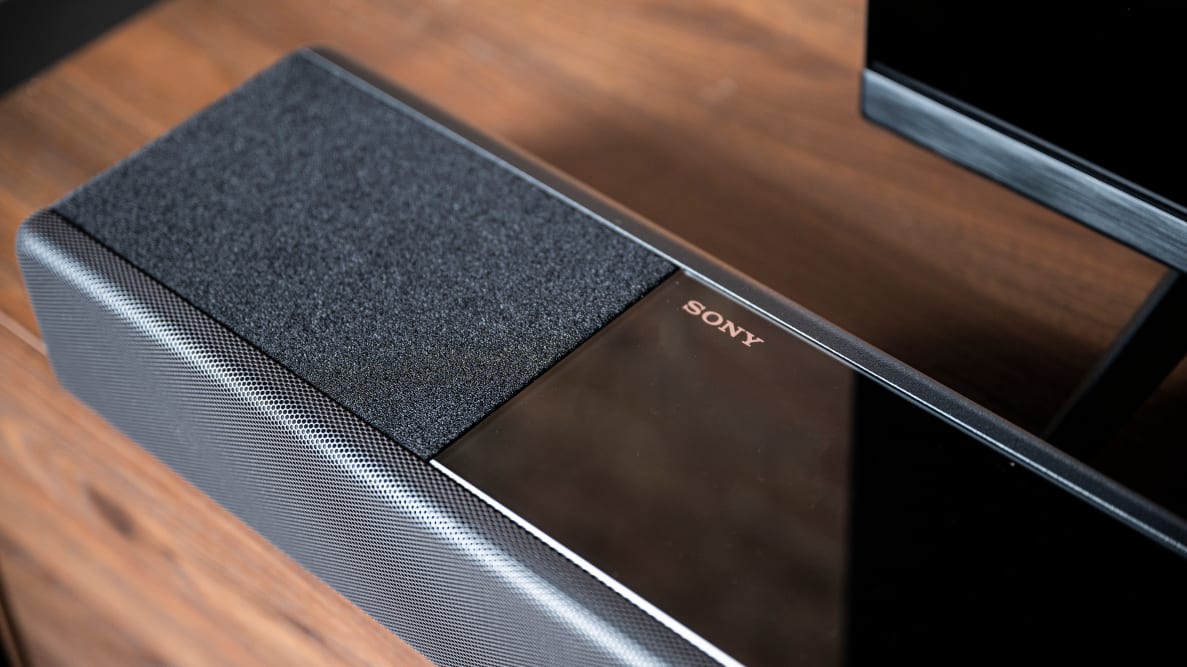Pros
-
Excellent virtual surround
-
Tons of features
-
Stylish design
Cons
-
No included subwoofer
-
Weak-sauce app
The premium soundbar space offers an increasing number of Dolby Atmos-ready models and configurations, from the Sonos Arc—another solo bar that can be supplemented with a subwoofer and surround speakers—to the Samsung HW-Q950A that’s loaded with more speakers and channels than anything on the market. And every one we’ve tested is, pound-for-pound, more affordable than Sony’s A7000.
But not everyone's on a budget. If you’re ready to splash out on a minimalist purveyor of home theater immersion that screams luxury inside and out, the A7000 could be just your speed.
About the Sony HT-A7000
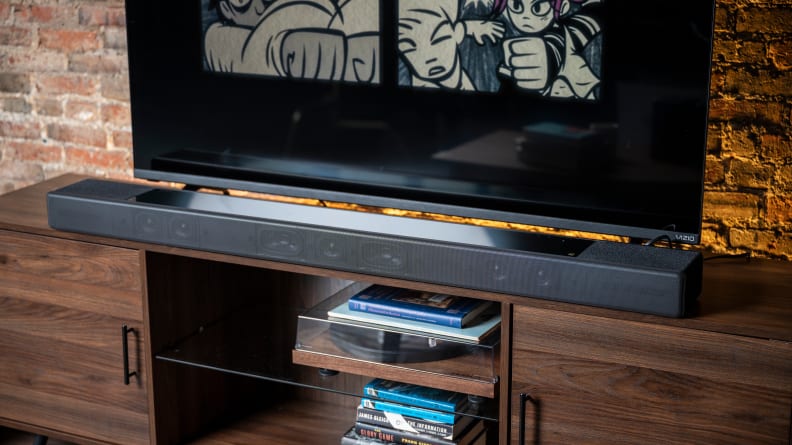
At just over 3 inches tall the bar should fit beneath most TVs, but there's an IR repeater in case it gets in the way of your TV's sensor.
The HT-A7000 replaces 2018's HT-ST5000, which included a bar and subwoofer for $1,500. Subwoofer aside, the A7000 ships with just about every feature available, including modern conveniences to help future proof it for the next generation.
Here’s a snapshot of its main specs:
- Height x Width x Depth: 3.25 x 51.25 x 5.625 inches
- Weight: 19 pounds 2 ounces
- Speaker channels: 11 discrete channels including built-in woofers, dual upfiring speakers, side-firing beam drivers, and left/center/right channels (subwoofer and surround speakers available for purchase)
- Amplification: 500 watts peak power
- Wireless connection: Wi-Fi, Spotify Connect, AirPlay 2, Chromecast, Bluetooth 5.0
- Wired connection: HDMI ARC/eARC, HDMI in (2), digital optical, analog, USB
- Smart features: Alexa and Google Assistant support (requires added speaker)
- Sound formats: Dolby Digital, Dolby Digital plus, Dolby TrueHD, Dolby Atmos, Dolby Dual mono, DTS, DTS HD High Resolution Audio, DTS HD Master Audio, DTS ES, DTS 96/24, DTS:X, LPCM, DSD, Wav, Flac, ALAC(.m4a, .mov), AIFF(.aiff, .aif), HE AAC, AAC, mp3, Monkey Audio, WMA, Ogg Vorbis
- Video support: 4K/HDR passthrough at 120Hz (includes Dolby Vision), 8K passthrough
In the box you’ll find the glass-topped bar in a sea of foam alongside an accessories box hosting a chunky remote and batteries (perhaps the least luxurious part of the package), an HDMI cable, a pair of mounting brackets, and a 3.5mm analog cable. There’s no optical cable here but unless you’re connecting a CD player you shouldn’t need one.
What we like
Relatively simple setup (and even an on-screen display!)
Connecting the A7000 is as easy as plugging the included HDMI cable into the corresponding HDMI ARC or ARC/eARC ports of your soundbar and TV. This is required for Dolby Atmos, and allows you to control volume and power with your TV remote. If you’ve purchased an add-on subwoofer and surround speakers, they should auto-connect when plugged in.
It’s refreshing to see the A7000 still hosting an on-screen display, a legacy feature from the heyday of A/V receivers that allows you to navigate virtually all settings from your TV screen with a tap of the remote’s Home button. From there you can connect to Wi-Fi, control settings from the IR repeater to the current input, and run the system’s calibration tool to tailor the sound to your listening room.
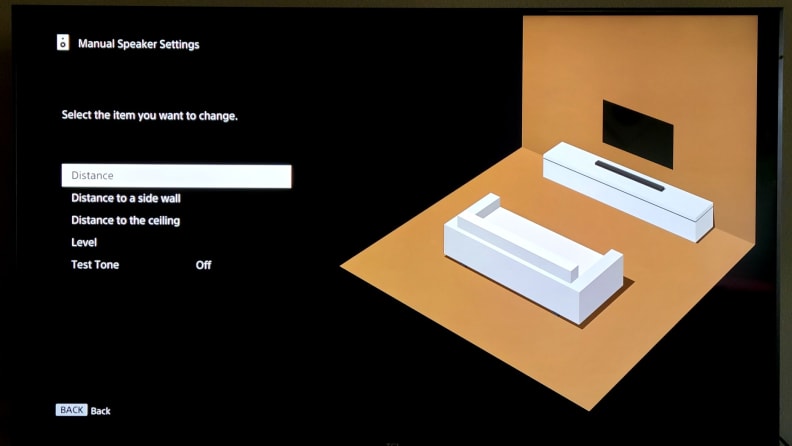
You can fine-tune most settings using the on-screen display, though I do wish you could control the center channel independently.
You can also manually tune select speaker settings by either adjusting the bar’s distance from the walls and ceiling or increasing the loudness of the side, front, or height speakers. There’s no apparent way to adjust individual channels such as the center channel, which seems like an odd omission, but the auto-calibration did a pretty good job setting levels for me.
It’s a good thing the on-screen display is fully loaded as Sony’s companion app is woefully lacking in options when compared to its rivals (more on that later).
All the home theater goodies you could ask for
Sony went all Jurassic Park on the A7000, sparing no expense for features.
You’ll get it all here, including virtually every audio codec we have a name for, from Dolby Atmos and Dolby TrueHD to DTS:X, DTS HD Master Audio, and everything in between. That takes all the mystery out of connecting outboard devices like gaming consoles and streaming devices via the soundbar’s dual HDMI inputs (something the Sonos Arc doesn’t have at all); whatever your system outputs, this bar can decode it.
You’ll also get high-resolution audio streaming (boasting Sony’s “Hi-Res” badge), and the ability to stream Sony’s 360 Reality Audio tracks, which are mixed or remixed using Sony’s own Dolby Atmos-like music ecosystem. I don’t have much love for 360 RA so far, and you’ll need a Tidal or Amazon Music Unlimited premium music service to stream it, but hey, it’s there.
Sony takes things further for gaming, allowing for passthrough of HDR/Dolby Vision, 4K content at up to 120Hz, and even (when you find a source someday) 8K video, though there’s no mention of support for features like VRR (variable refresh rate).
Smart assistant support includes both Alexa and Google Assistant. There’s no built-in mic so you’ll need a supported smart speaker for voice control, but that could be a plus for those worried about privacy issues. As far as streaming, alongside Spotify Connect and Bluetooth, you’ll also get Chromecast and Apple AirPlay 2 support. It’s pretty much the whole enchilada.
A smooth and balanced sound signature
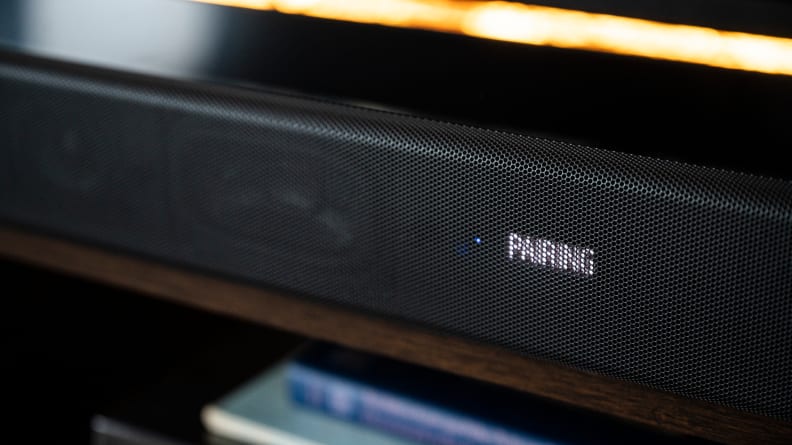
Bluetooth is one of many ways to stream, including AirPlay 2, Chromecast, and Spotify Connect over Wi-Fi.
Coming from my ultra-clear KEF LSX 2.1 setup (including a Pioneer Elite subwoofer), it’s often an adjustment to a soundbar which, by its nature, has to do a lot more for the money than my stereo-based system. As such, I wasn’t blown away by the detail and presence of the A7000 right out of the gate, but it’s a pleasant performer when fed the right content.
The bar sounds rather pedestrian for its price point on some stereo content, most notably comfort-food sitcoms on Hulu like Frasier or Modern Family, but ramps things up a fair bit for high-quality dramas like Mike White’s addictive mini-series The White Lotus. The ominous drums and spooky ambient sounds at the intro are especially impressive, and there’s compelling detail to the rapid-fire dialogue.
The A7000 is also a solid performer for music streaming over both hi-res streaming services and Spotify, offering good instrumental separation, impressive balance, and rich textures to instruments like synths and strings. Depeche Mode and The Weeknd were favorites, but The Beatles’ “Eleanor Rigby” was also lovely, as the bar pulled out the granular textures of the haunting strings with a deft hand. I’d put the A7000 inline, or slightly above Samsung’s Q950A in stereo, though the Q950A does better if you like to add in some surround thanks to its extra speakers.
Brain-bending virtual surround
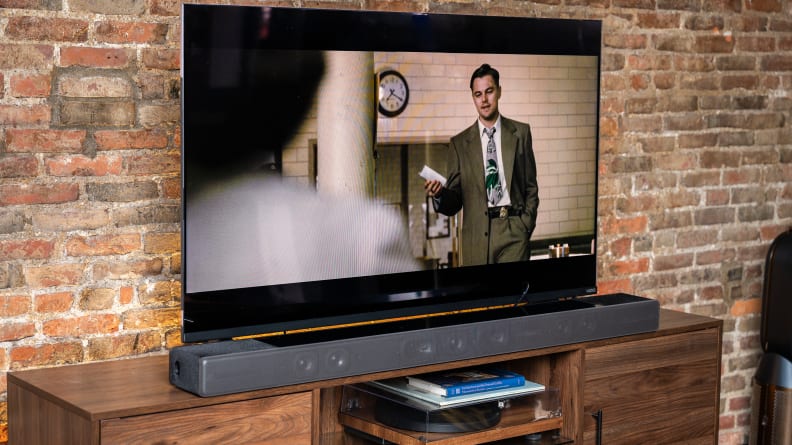
The HT-A7000 does a fine job filling your room with sound thanks to a mix of excellent virtual surround and well-tuned speakers that bounce sound around the room.
Virtual surround sound gets a lot of attention in the soundbar (and gaming) space, but it’s often notoriously disappointing when compared to the real deal. It’s difficult to defy the laws of physics.
Sony is one of the few brands that provide a convincing illustration, and the HT-A7000 brings Sony’s best version of this trick yet, using its new S-Force Pro system for advanced digital frequency manipulation. (There’s also a virtualizer designed to bring the height element to regular content, but it’s not all that convincing.) Add in the bar’s side-beam and upfiring drivers to bounce sound off your walls and ceiling, and it’s a pretty slick ride. You could tack on Sony’s SARS3S surround speakers for true surround (at a serious markup) but you may not need them.
From the moment I heard the first surround demo, I knew I was in for a treat. It’s a funny feeling when, despite what your eyes are seeing, your brain says there are actual objects floating around and even behind you. The latter is the hardest trick to pull off without surround speakers, and the A7000 gets the closest I’ve heard in a soundbar since Sennheiser’s check-behind-the-walls Ambeo soundbar ($2,500).
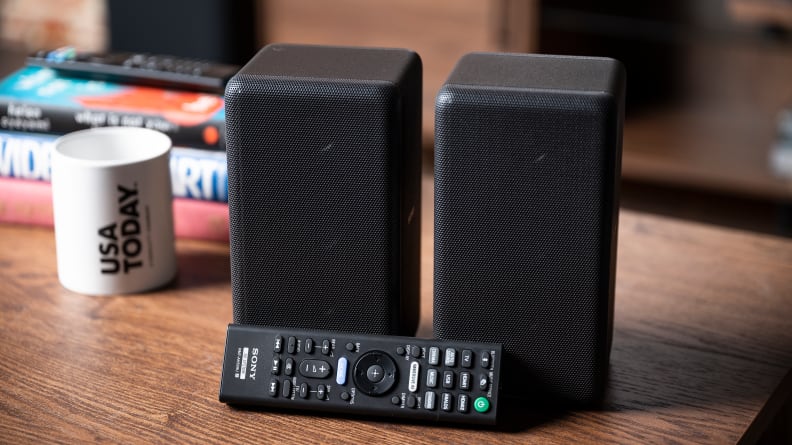
The remote is boxy and the speakers pricey, but you may not need either for most situations.
As usual, Dolby Atmos demo clips, which add the all-important height element, provided the most enthralling examples. The Amaze clip engulfed me in the sizzling buzzes of a forest, while the circular rotation of a bird fluttered almost perfectly behind my head. The raindrops coming down overhead were also relatively realistic, though without a sub the booming thunder didn’t have its usual guttural force.
In another clip, Audiosphere, I was struck by just how accurate the placement of all the digital effects felt, seeming to perfectly explode in sync with the sparse on-screen visuals.
The immersion continued when I dialed up one of my favorite Dolby Atmos test films, Ant-Man. From the funky groove of a clavichord to the first shrink scene in the bathroom, in which a wall of shower water engulfs our hero like a tidal wave, it was thoroughly engaging. Throughout testing, I was regularly dazzled by the bar’s ability to both fake it and make it.
What we don’t like
No included subwoofer is rough at this price
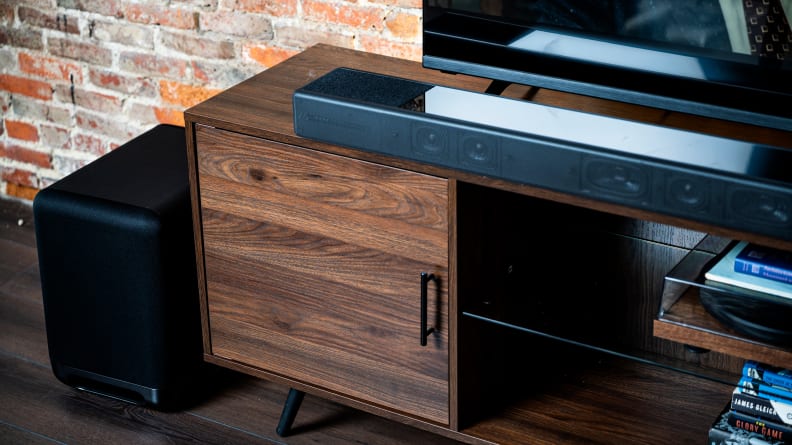
While the soundbar does pretty well on its own, the add-on subwoofer provides another dimension of cinematic punch.
The one caveat that holds back the A7000’s cinematic punch is the lack of convincing lower bass. While the bar goes impressively low for something so slim, stretching its way down toward the bedrock like a teenager in a barbershop quartet, you simply won’t get the full-throttle punch you’d experience with even a mediocre subwoofer.
As touched on above, this dampens the visceral effect of scenes like cracking thunder, the ominous buzz of space, or explosions in your favorite action flicks. If I were to upgrade the A7000, even at $400, the sub would be my first move.
A very limited app
While the on-screen display is a fun and useful inclusion, especially for aging A/V nerds, in 2021 most of us expect an app with a wide catalog of available settings. Sony’s Music Center app offers a few settings, but it’s pretty lacking overall, especially when compared to apps from Samsung, LG, and particularly Sonos, which let you control the vast majority of features from the palm of your hand—without the need to disrupt your favorite show.
Should you buy it?
Yes—if you fit the profile
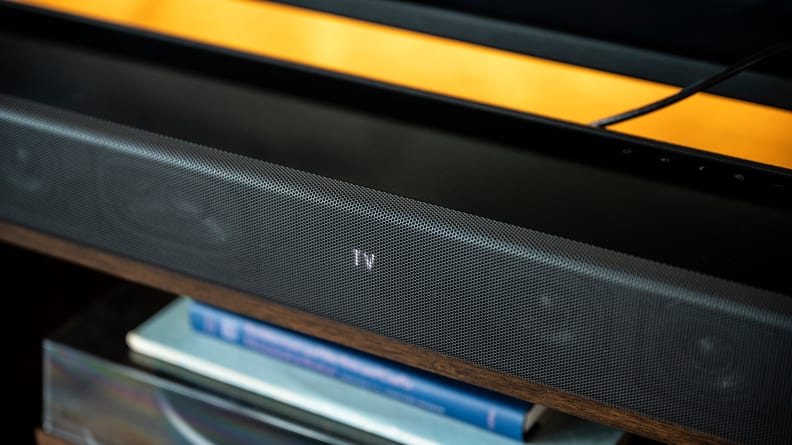
The Sony HT-A7000 can serve well as your only sound system for most situations.
Sony’s HT-A7000 is a ringer of a soundbar, offering some of the very best virtual surround performance I’ve heard, a truckload of connectivity options and features, and a sweet and well-balanced soundstage. For what it is—a black slab of sound—it’s also pretty attractive looking. But you’ll really have to be someone who doesn’t pay much attention to price tags to buy it. At $1,300 with no sub (and $400 to add one), the A7000 faces a throng of heartier competitors from a sheer value perspective.
For just $800, the Sonos Arc offers similar Dolby Atmos punch, great sound, and tons of versatility in a singular bar. While it doesn’t have all the home theater goodies of the A7000 (surprisingly lacking a single HDMI input), it runs on powerful software and a great ecosystem. On the other end, there’s Samsung’s HW-Q950A, which packs 22 drivers, four speakers, and the majority of the A7000’s home theater trimmings at a far lower per-component cost (especially on sale).
Those are just a couple of options. Vizio’s Elevate is a shockingly affordable 4-piece system with impressive styling, great features, and performance, often priced well below $1,000. And there are plenty more lower-priced options from Samsung, LG, and others. Not to mention the fact that you can nearly get a full, multi-speaker A/V surround system for the A7000’s price tag when you add on its sub and surrounds.
Sony’s HT-A7000 is undoubtedly impressive, especially if you want a future-proofed, singular bar capable of filling in for a full surround system. If its $1,300 admission price doesn’t make you blink, you could be the perfect candidate to bring this system home.
Meet the tester
Hailing originally from Montana, Ryan parlayed his time working as a musician and audio engineer into a career in digital media in 2012. Since then he's had extensive experience as a writer and editor, including everything from op-eds and features to reviews on TVs, audio gear, smart home devices, and more.
Checking our work.
Our team is here to help you buy the best stuff and love what you own. Our writers, editors, and experts obsess over the products we cover to make sure you're confident and satisfied. Have a different opinion about something we recommend? Email us and we'll compare notes.
Shoot us an email